Olivia Rode Hvass with her Hunt(ed) installation during Luxembourg Art Week Curated by Çağla Erdemir
When Olivia Rode Hvass weaves a crying horse into digital jacquard tapestries and surrounds it with withering sunflowers in a bed of hay, she's creating a language for vulnerability that neither the past nor present could articulate alone.
Her Jacquard tapestries reimagine "The Hunt of the Unicorn," a 16th-century tapestry series that celebrated capture as triumph. Hvass's version rewrites this hunting myth to show the hunted's perspective: fear, pain, hiding.
The scarecrow-hunters woven into her tapestries represent state systems that claim to guard but often harm.


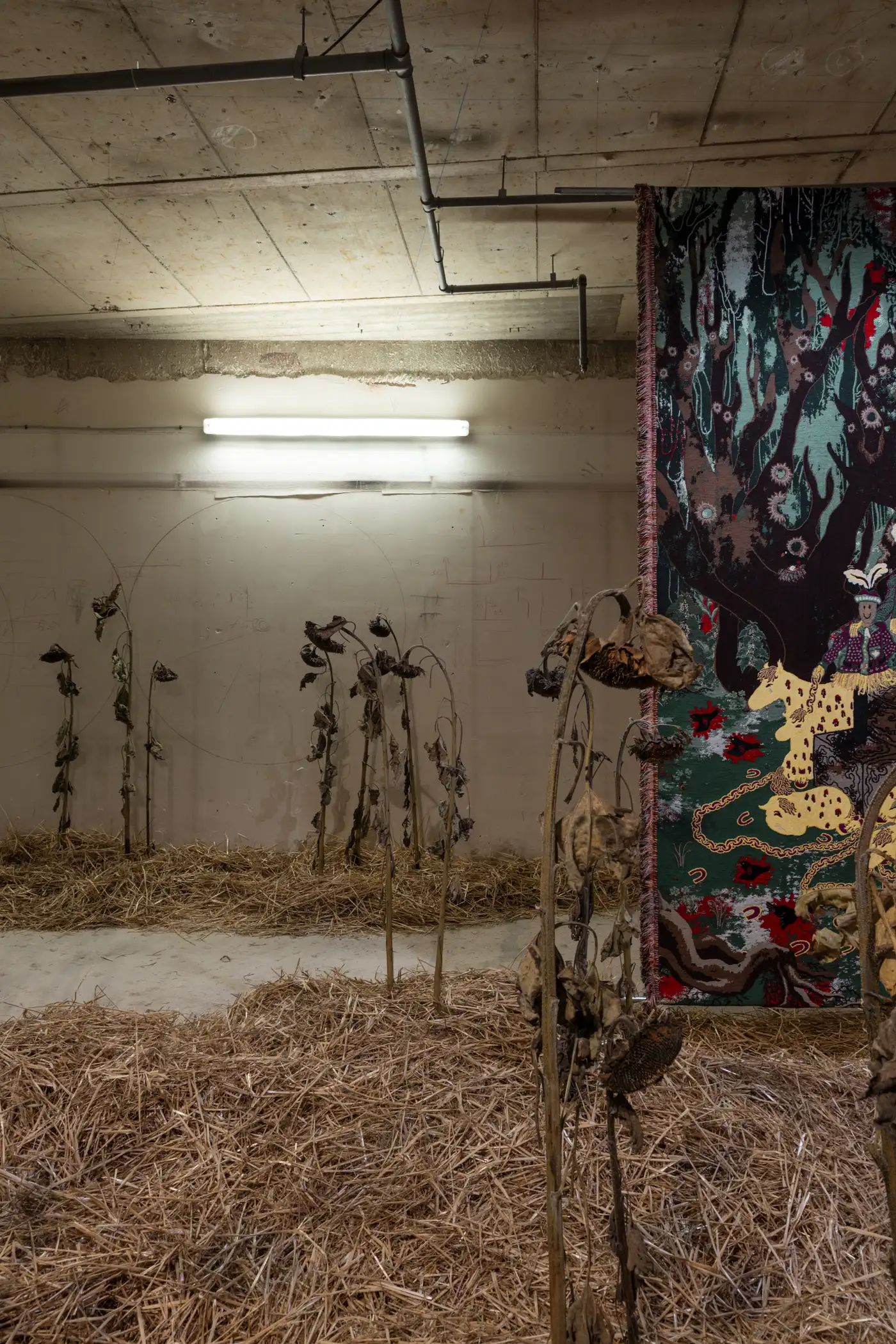
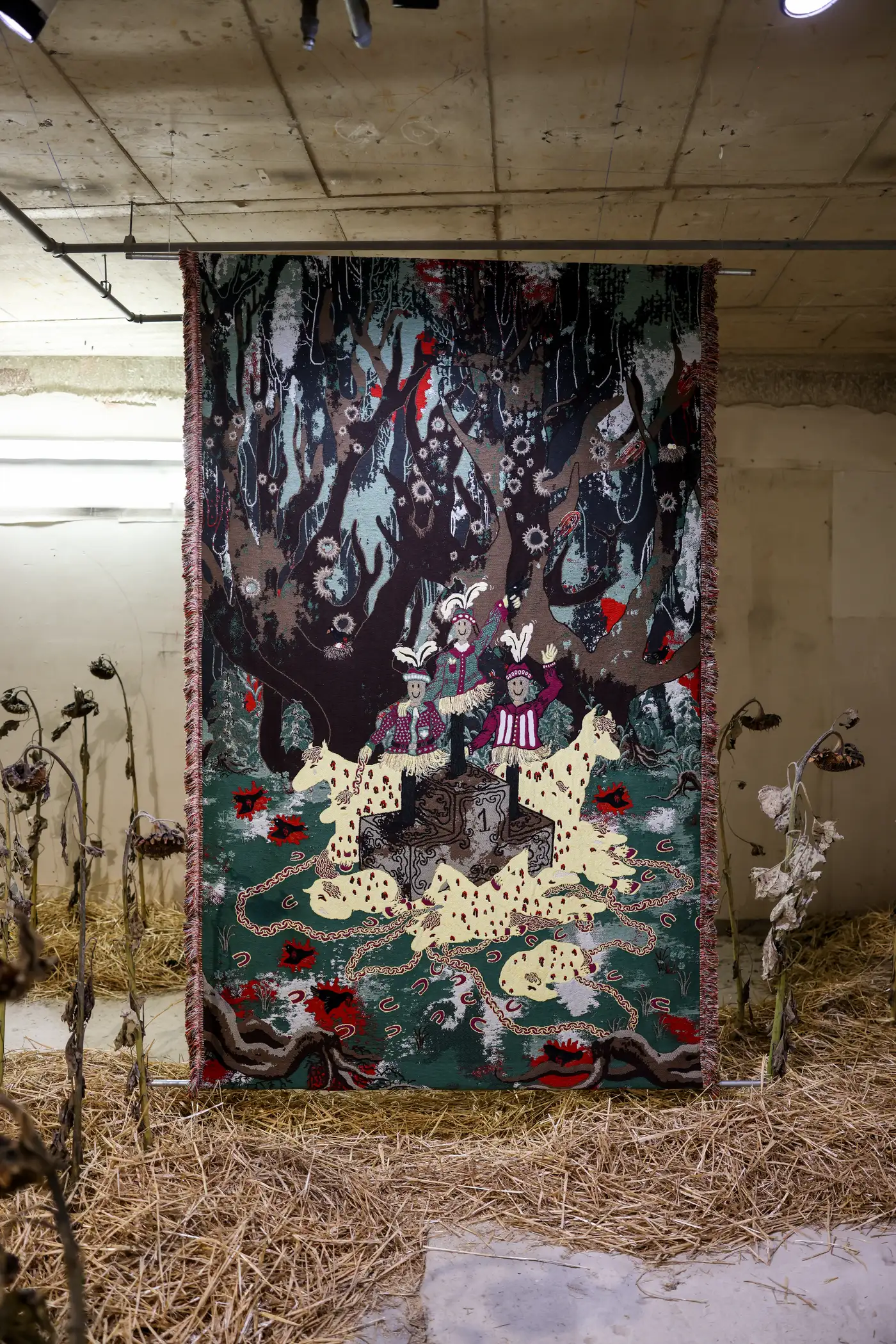
Luxembourg Art Week, Capsules Curated by Çağla Erdemir Installation view Artist: Olivia Rode Hvass Photo © Patty Neu and Sophie Margue
When protectors become predators, the yellow-spotted horse has nowhere safe. And presenting this in a commercial storefront window, part of Luxembourg Art Week's Capsules section, turns the work into confrontation.
Storefronts sell. This installation refuses.
Hunt(ed): What You'll Actually See
Three digital jacquard-woven tapestries hang in Centre Neuberg's storefront windows at 7, place du Théâtre.
The central piece shows a yellow-spotted horse, crying, surrounded by scarecrow figures dressed as medieval hunters. The horse is grounded, relatable, vulnerable. No horn. No magic. Just a body trying to survive.
Around the tapestries, dozens of withering sunflowers stand on their own stems, their heads heavy and dying. Hay covers the concrete floor. The space smells organic, earthy, wrong for a commercial district.
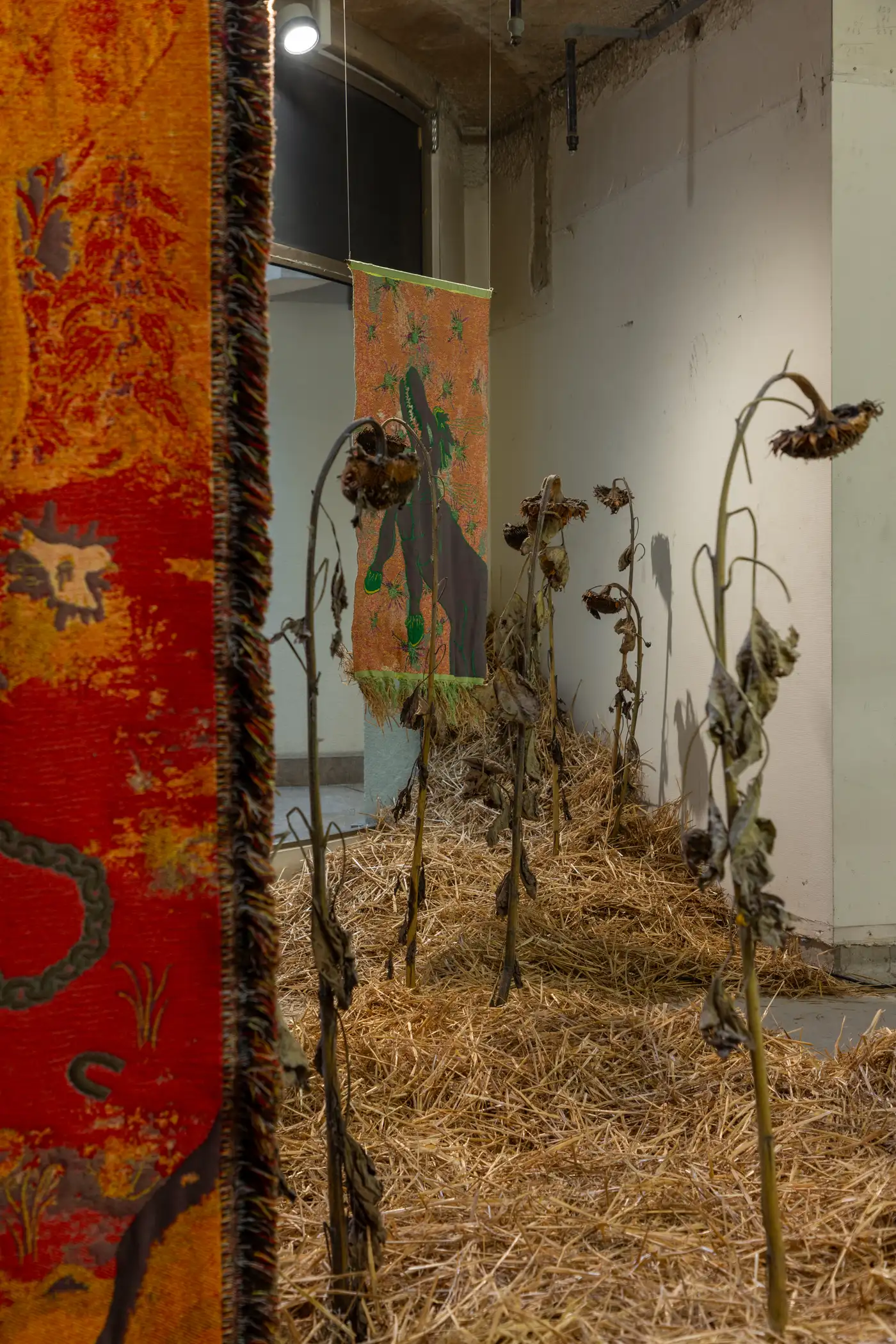
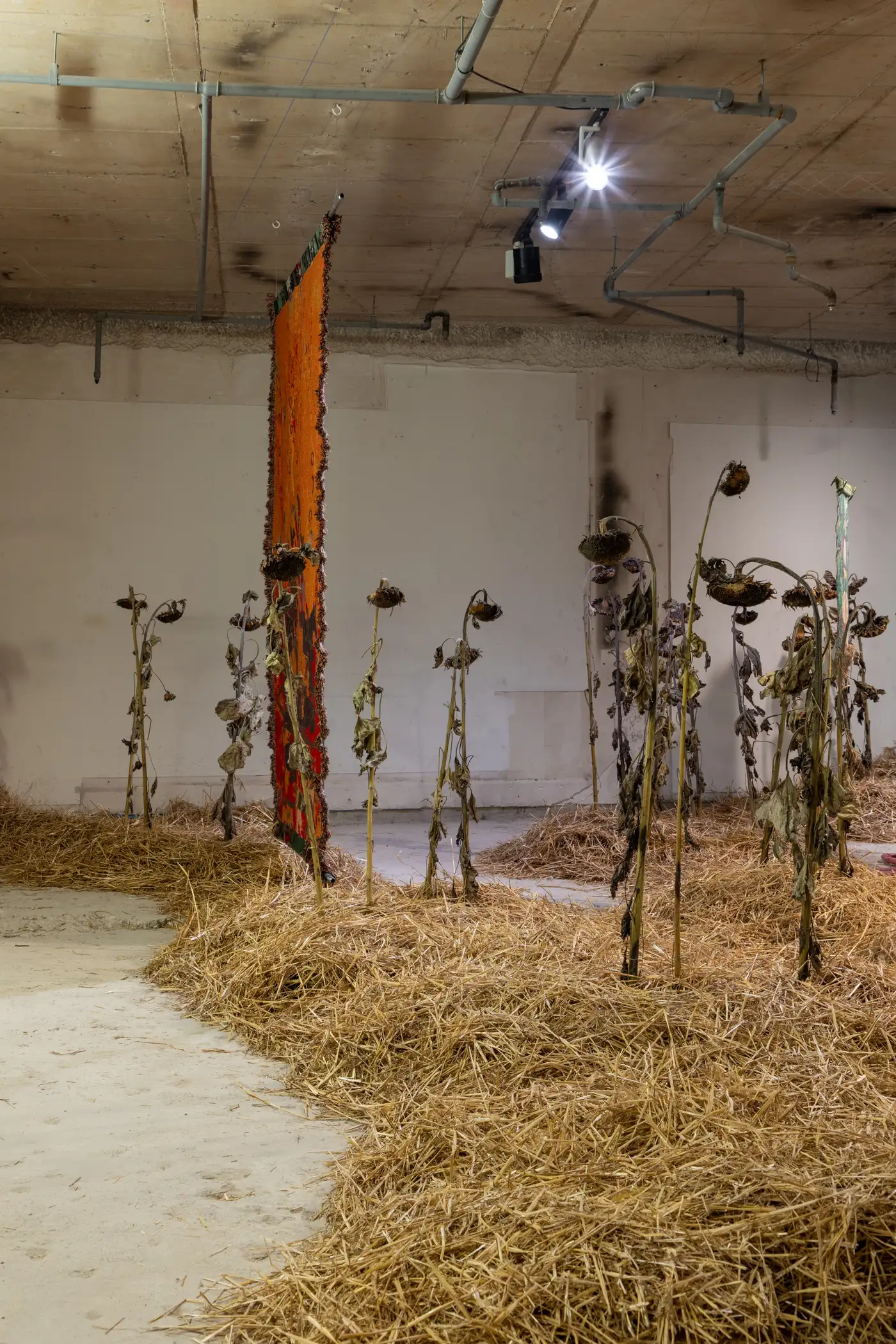
Çağla Erdemir curates Capsules, the 24/7 exhibition at Luxembourg Art Week. Shown here is Olivia Rode Hvass with her installation HUNT(ED), photographed by Patty Neu ©PattyNeu
The sunflowers work in their own logic, representing failed crops, a sadness and eeriness in the atmosphere. They also contrast the high art feeling, placing something culturally valued in hay and withered flowers, in a dusty concrete space. Something about class, economy, life expectancy. The flowers are fragile, biodegradable.
The tapestries themselves are technical marvels. Digital jacquard weaving allows Hvass to create imagery with the precision of a screen and the materiality of medieval craft. The yellows glow. The scarecrows loom with stitched faces that could be protecting or threatening.
From Unicorn to Horse (Why the Transformation Matters)
Hvass's starting point is the 16th-century tapestry cycle "La chasse à la licorne" (The Hunt of the Unicorn), where nobles capture a mythical creature and cage it.
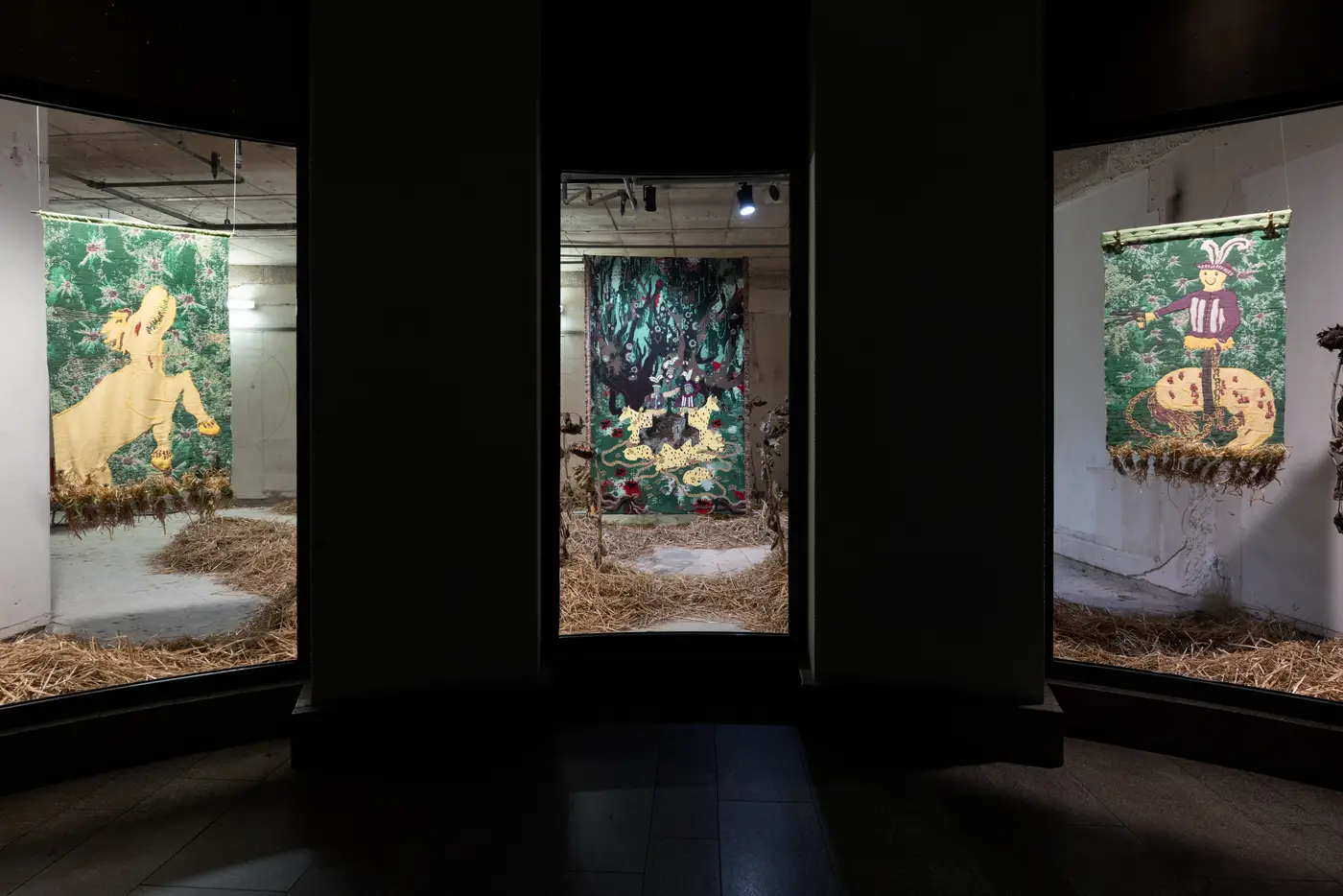
The unicorn in those tapestries represents the exotic, the magical, the Other. Something to possess.
Hvass removes the horn. The unicorn becomes a teenage My Little Pony-like horse, spotted yellow, ordinary. "Making something magical, exotic, different, can sometimes be a way of othering something or someone," Hvass explains. "It's easier to want to possess it if it's not something you relate to. My idea was to take away the horn, to make it more grounded and relatable." – From the Interview with Miriam Schmidt
The horse is crying. Hiding. The hunt is not glorious. It's violent.
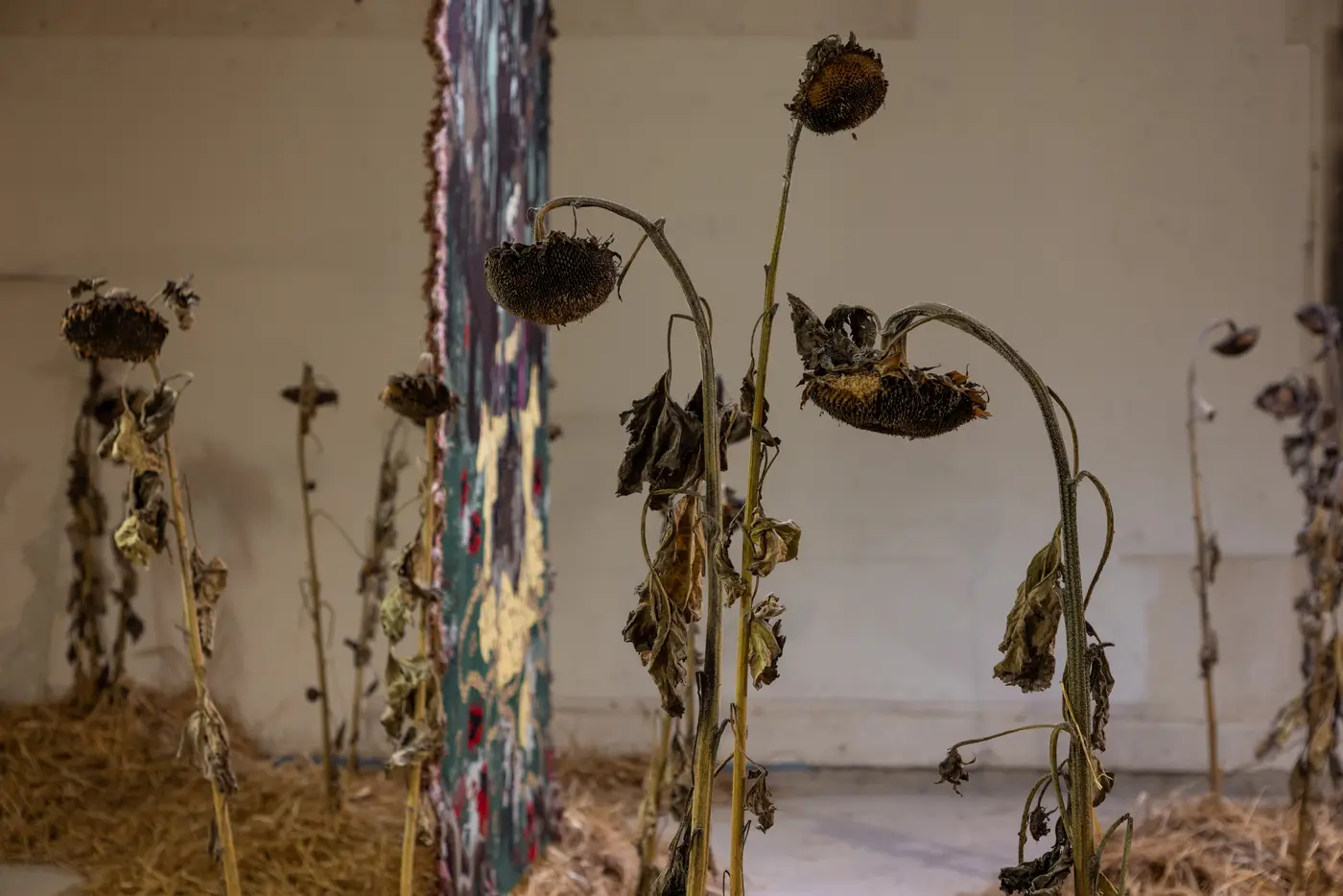
The shift from unicorn to horse is a shift from fantasy to body, from myth to flesh. When you remove the magic, what's left is harm.
Scarecrows as State Systems (The Protector Problem)
The scarecrow-hunters appear woven into the tapestries, figures meant to protect fields but positioned here as predators.
"The scarecrow both represents the hunter in the original tapestries and also the given caretakers or caregivers today," Hvass says.
"Like the state, police, welfare systems, etc., all meant to protect, but it very much depends on your status in society, whether you're homeless or house owner, refugee or native, sick or not." – From the Interview with Miriam Schmidt
This is the core paradox of Hunt(ed). Protection and threat are not opposites. They're the same structure viewed from different positions. A scarecrow keeps birds away from crops.

Who decides who's the bird and who's the crop? Immigration systems protect borders but kill refugees. Welfare bureaucracies offer support but punish the poor. The scarecrow contains that ambivalence: protecting the land but scaring the birds.
Hvass doesn't resolve this tension. She positions it front and center, woven into the imagery, unavoidable.
Why Storefront (The Capsules Context Matters)
Luxembourg Art Week's Capsules section takes over vacant spaces and store windows in the city center.

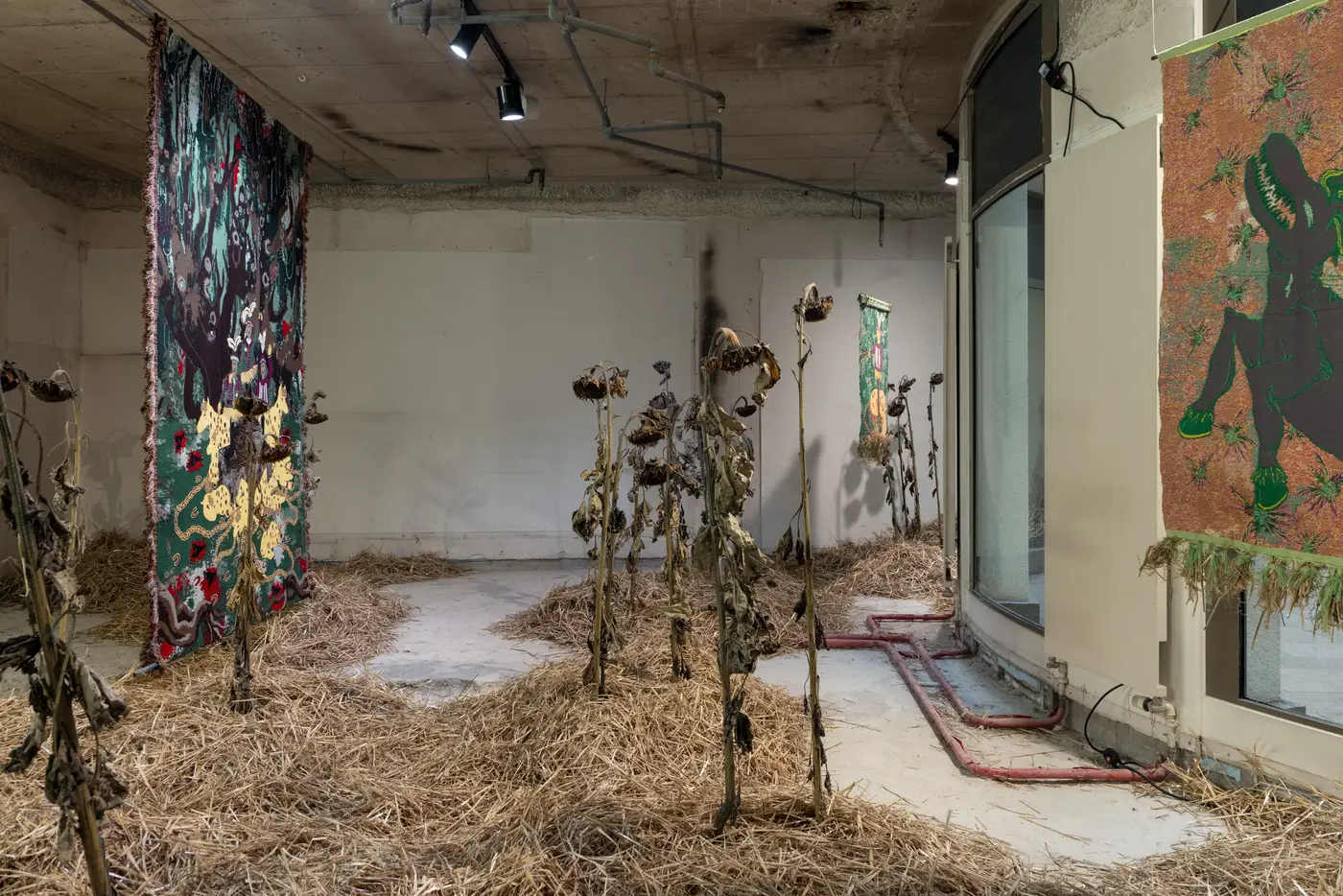
Hunt(ed) is not behind gallery walls where you choose to enter. It's in a shopping district where you're passing by with other intentions.
The storefront creates a threshold. You can see in. You can't enter without effort. The glass both displays and protects. "Showing it in a window makes the scarecrow and the hunted horse feel even more ambivalent," Hvass notes. "They are visible, exposed, almost like actors in a play of protection and threat." – From the Interview with Miriam Schmidt
Storefronts are designed to sell. They seduce with promises of luxury, newness, consumption. Hunt(ed) offers decay. Withering flowers. Hay.
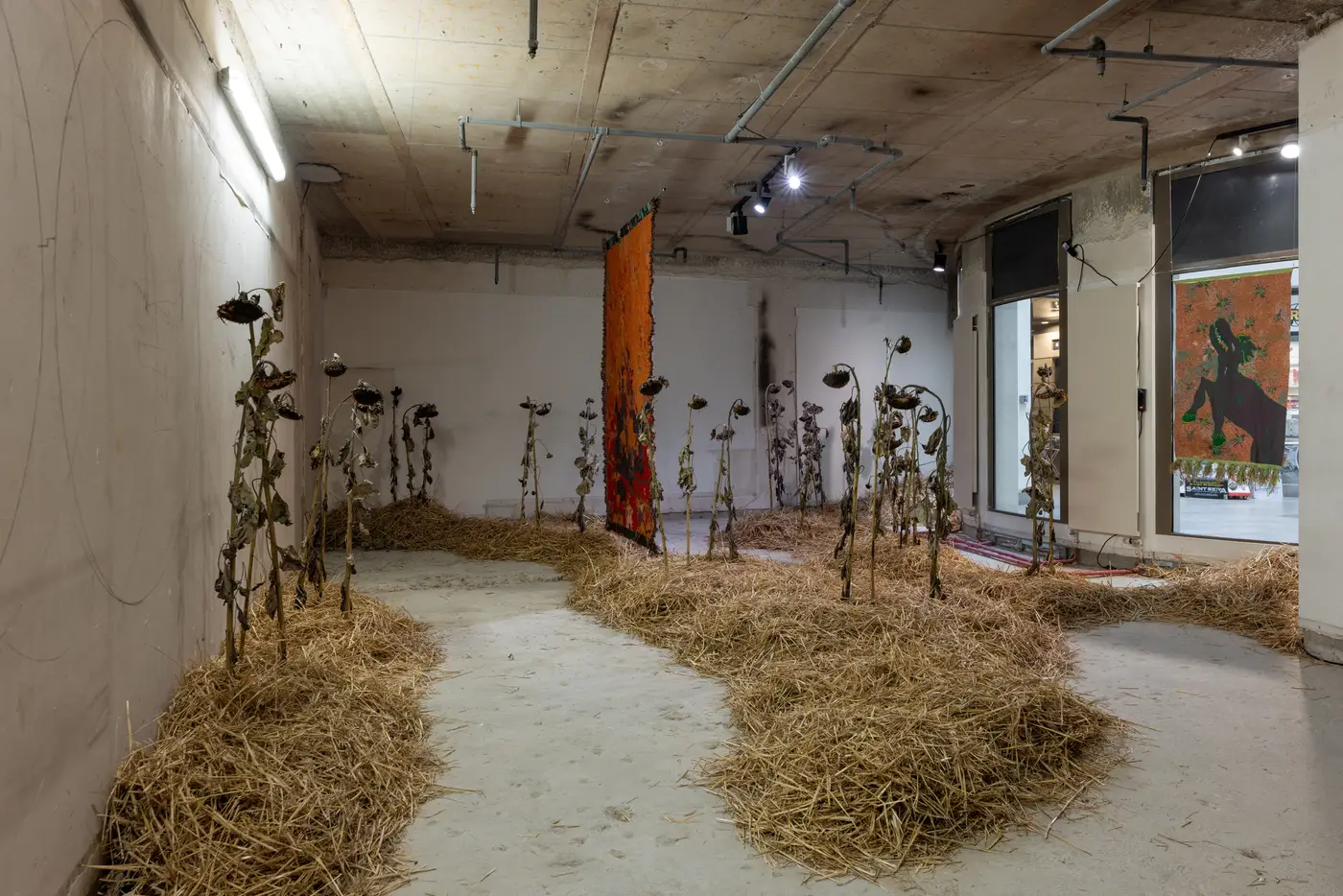
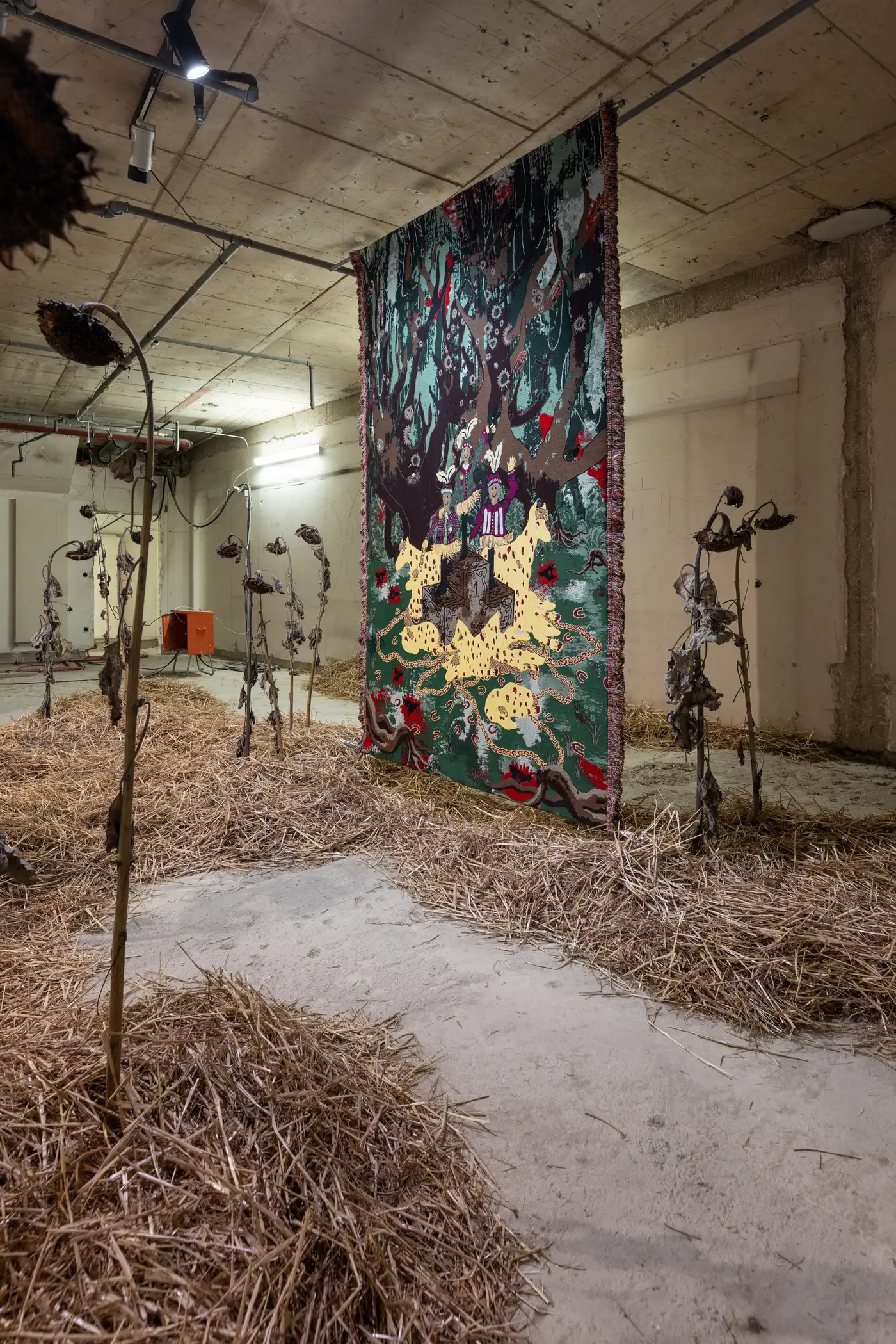
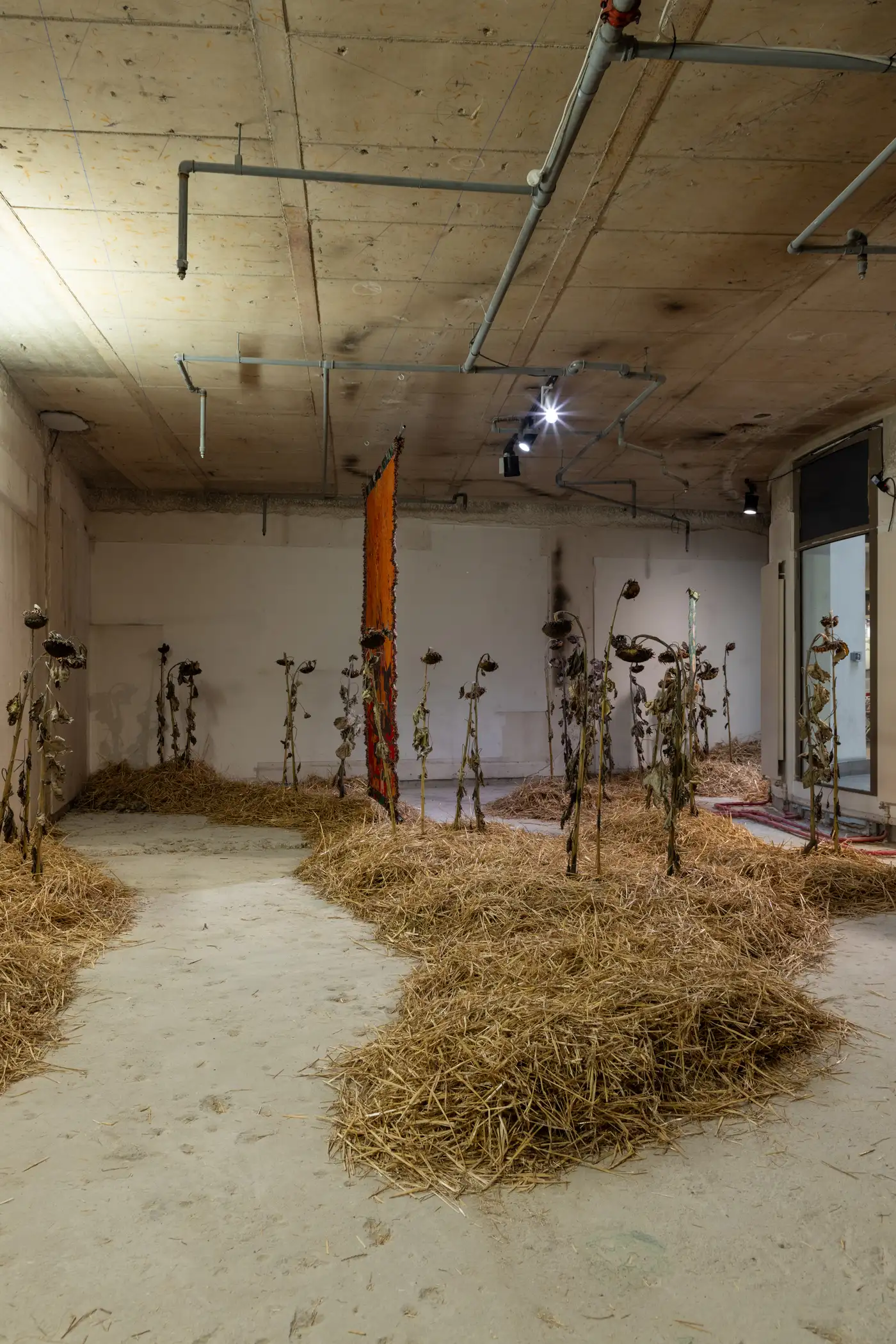
Details of the Installation HUNT(ED) by Olivia Rode Hvass Photo © Patty Neu
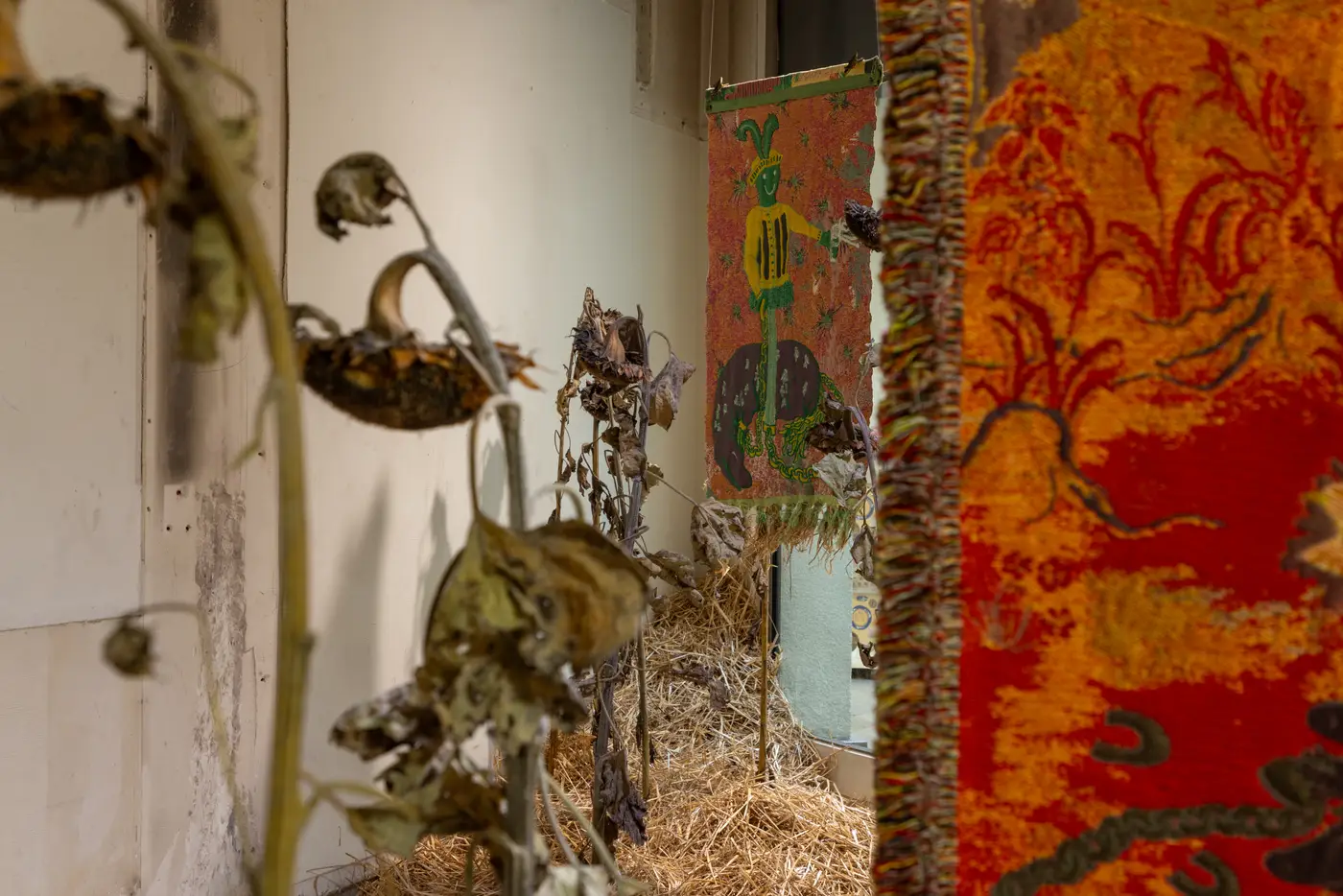
A wounded animal. The refusal is quiet but total. In a city like Luxembourg, tied to finance and commerce, this gesture sharpens. The capital flows. The horse cries. Business happens. The flowers die.
Myth as Critique
Hvass is drawn to myths because they encode societal morals, power structures, justifications for violence. The Hunt of the Unicorn is a myth of conquest. Noble men capture a rare creature. It legitimizes domination.
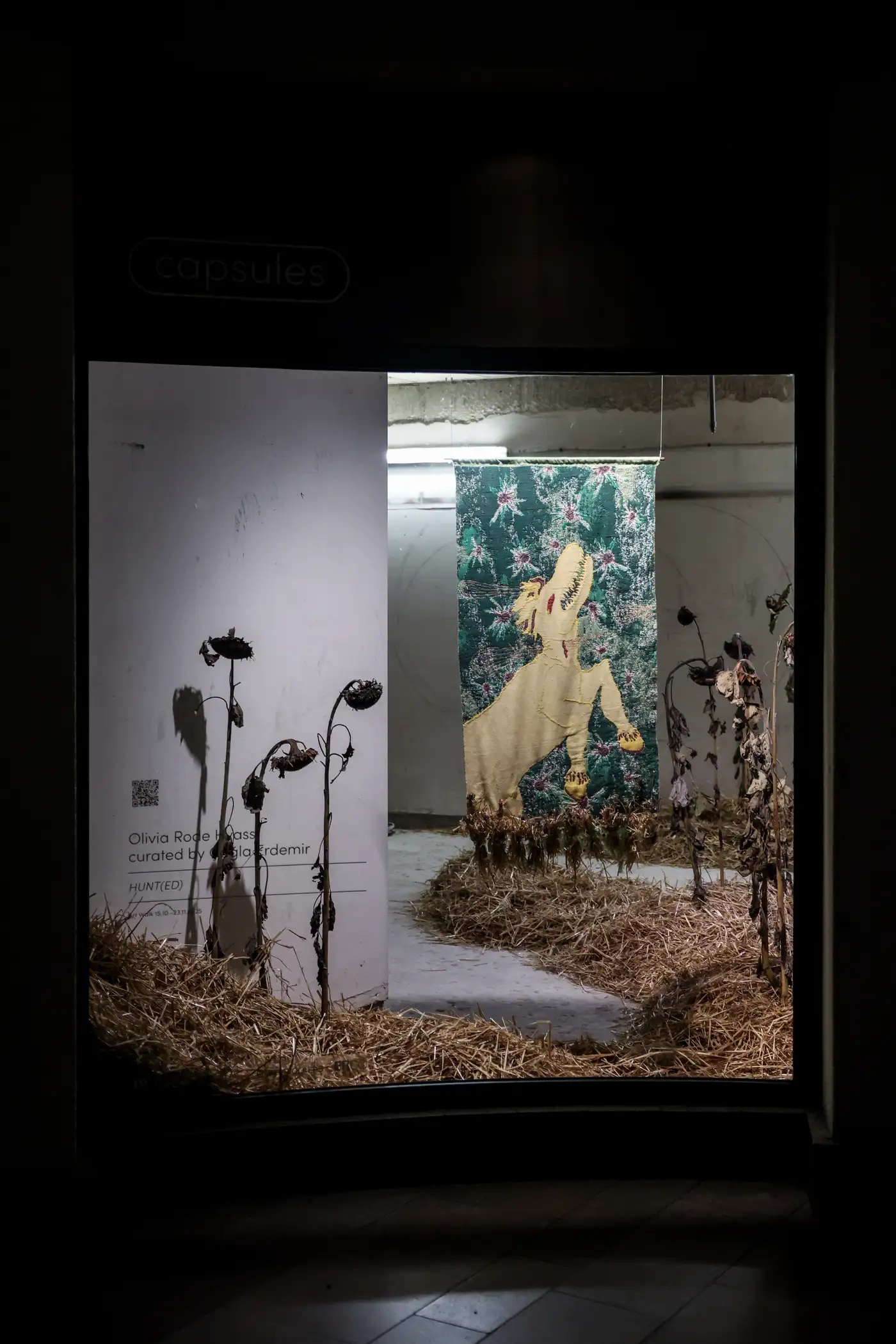
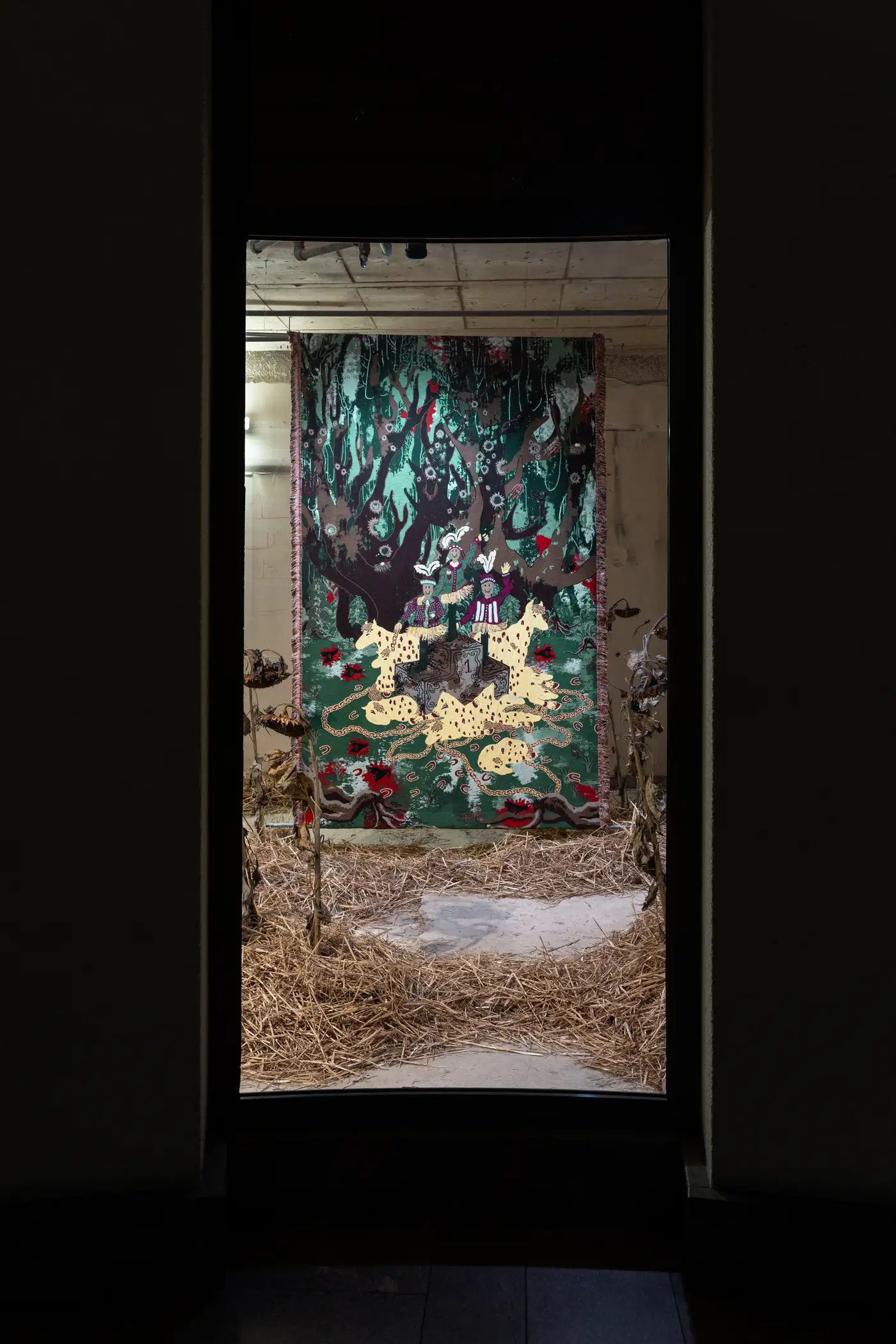
Olivia Rode Hvass, HUNT(ED), Art Walk, Luxembourg Art Week 2025 Photo © Sophie Margue and Patty Neu
Hvass rewrites the myth to expose what it hides. By shifting perspective from hunter to hunted, by replacing nobles with scarecrows, by showing tears instead of triumph, she asks: whose stories get told as myths? Whose suffering is aestheticized?
"In fiction you are more ready to take your own prejudice away and open to look into new opportunities, other ways to think," Hvass says. "I think this fictional space has quite a lot of potential." – From the Interview with Miriam Schmidt
This matters because we're living through a crisis of narrative. Who gets to be the unicorn and who gets to be the hunter?
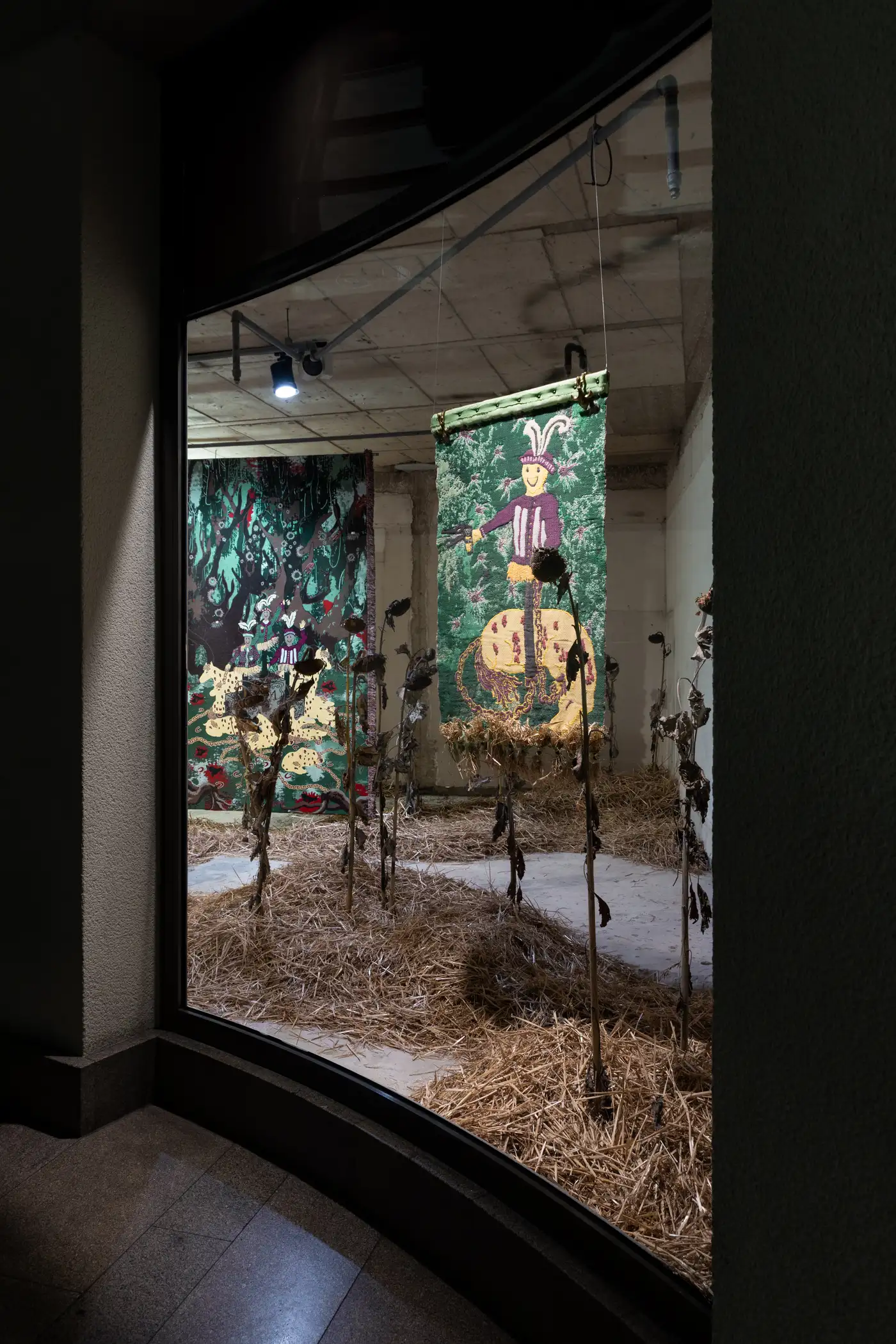
The question applies to refugees, to trans bodies, to anyone marked as different and therefore targetable. Myth creates distance. Hvass's work collapses that distance.
Care in Crisis
There's a tension running through Hunt(ed): how do you make contemplative art about care when the world is burning?
Hvass names this directly. "I am worried about the state the world is in right now. About war and fascism. About the Palestinian people, and also very much about the reaction and carelessness regarding the genocide by my country and most European countries." – From the Interview with Miriam Schmidt
This is not background noise. It's the context in which Hunt(ed) exists. The work is quiet, slow, focused on vulnerability.

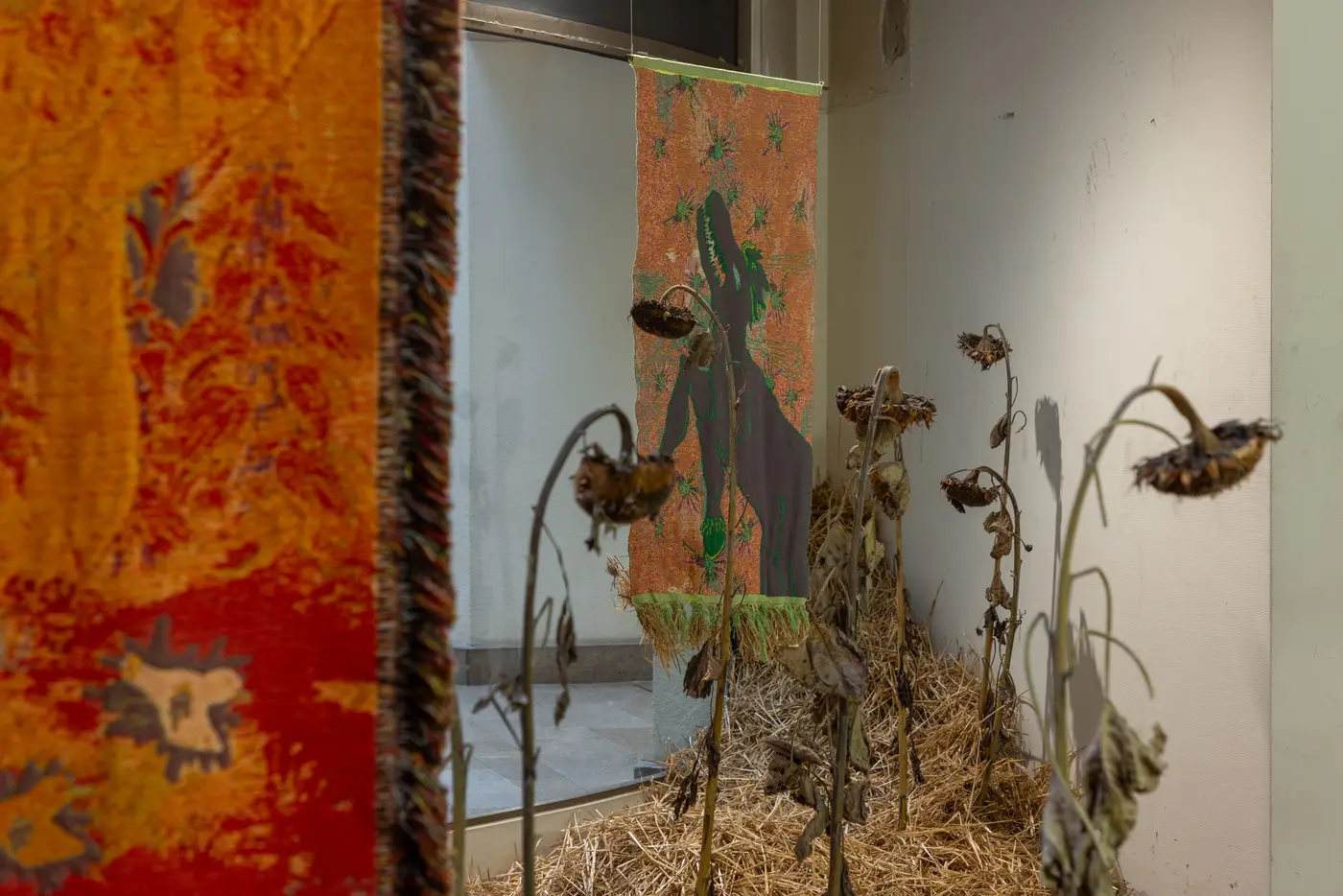
Meanwhile, states commit genocide. Systems fail. The tension between the contemplative register and the urgency of crisis is uncomfortable. That discomfort is honest.
"I think connecting makes a lot of sense right now," Hvass continues. "To think about community more than the self. But perhaps more so in doing community work, helping each other and going to the streets to demonstrate." – From the Interview with Miriam Schmidt
Hunt(ed) is not activism. It's art that creates space for empathy, for slowness, for care. The work holds fragility, not heroism. "These are not heroic stories, but vulnerable ones," she says. "If people stop and sense that vulnerability, whether it makes them sad, reflective, or protective, then I think the work has opened a space for empathy."
About Olivia Rode Hvass
Olivia Rode Hvass (b. 1995, Copenhagen, Denmark) creates fantastical universes that explore storytelling and world-building.
Coming from a background of family neglect and mental illness, Hvass is drawn to alternate realities, care, magic, and mystery, while remaining critical of established narratives and societal norms.
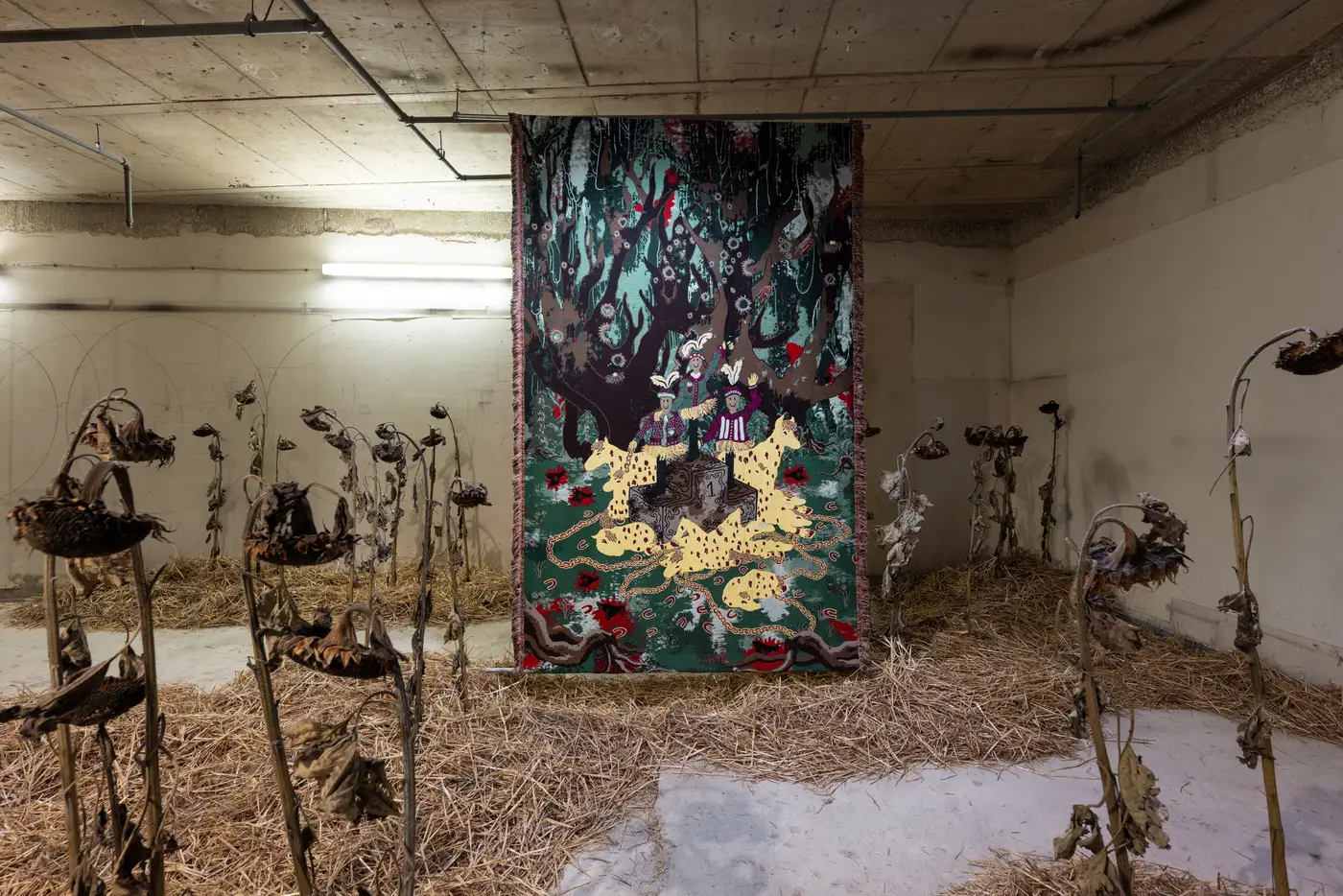
Hvass works primarily with installation, often including large-scale digital jacquard weaving, a technique that allows for intricate imagery with both contemporary precision and historical textile weight.
Hunt(ed) is part of a larger series that reimagines The Hunt of the Unicorn, with some works showing the horse's escape and freedom.
Catapult - The Munchies Art Club has been following Hvass's career for years. The evolution toward this politically charged, structurally critical work is thrilling.
Exhibition Details
Hunt(ed) by Olivia Rode Hvass - on Instagram
Curated by Çağla Erdemir - Instagram
Part of Capsules, Luxembourg Art Week - Instagram
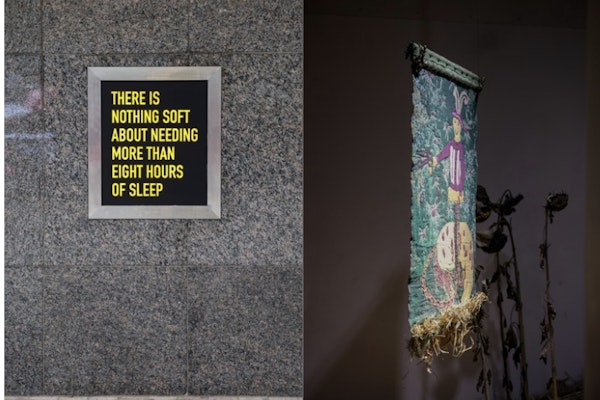
Full Interview - Miriam Schmidtke for Luxembourg Art Week conducted by Livia Klein.
Location: Centre Neuberg, 7 place du Théâtre, L-2613 Luxembourg
Dates: Visible during Luxembourg Art Week
Access: Visible 24/7 from the street through storefront windows
The work includes three digital jacquard-woven tapestries, withering sunflowers, and hay installation.
What Will You See When You Stop?
Hunt(ed) asks a simple question: when you walk past a storefront displaying a crying horse, dead flowers, and woven predators, will you keep walking or will you stop?
The work doesn't demand an answer. It just holds the space. Visible. Vulnerable. Refusing to be consumed.
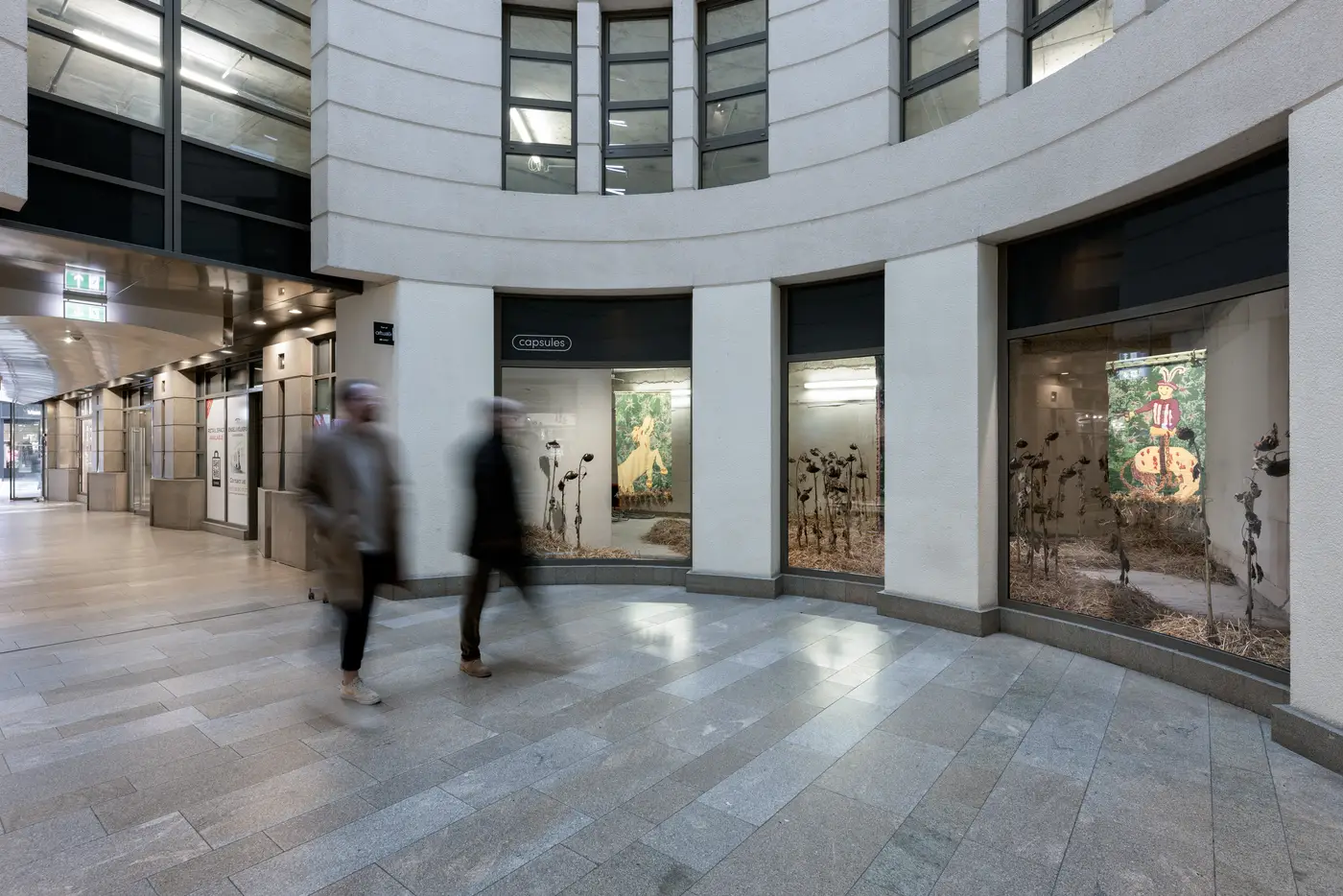

If you're in Luxembourg during Art Week, lean into the glass. Look at the yellow-spotted horse.
Notice the scarecrows woven into the tapestries. Count the dead sunflowers. Let yourself feel whatever rises: sadness, protection, recognition. That's the space Hvass is building. Not heroic. Not resolved. Just held.
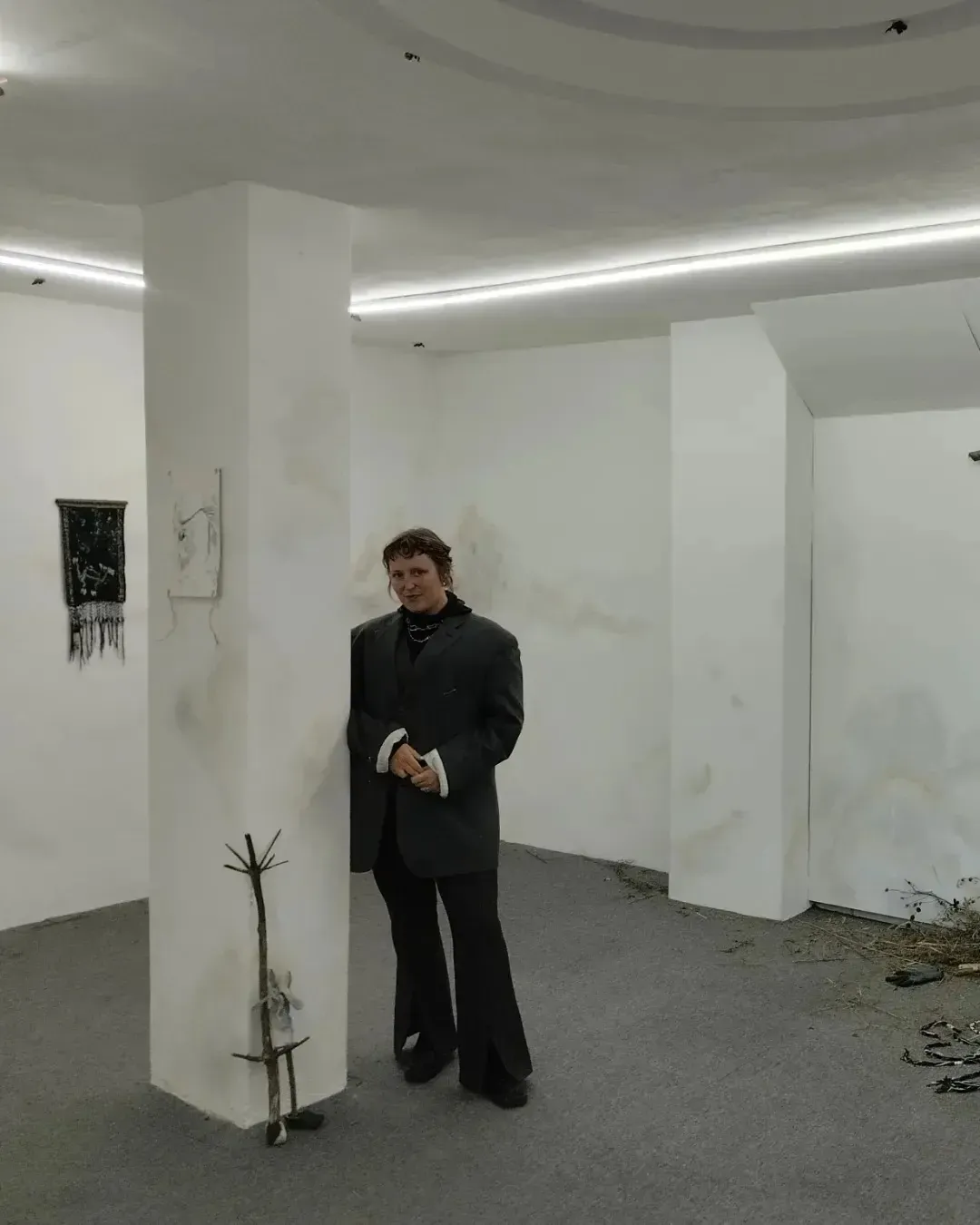
Read more about Olivia Rode Hvass on Catapult - The New Munchies art Club
Jacquard tapestries met crying horses and dead sunflowers. What happened is still unfolding in that storefront window. Go see it.


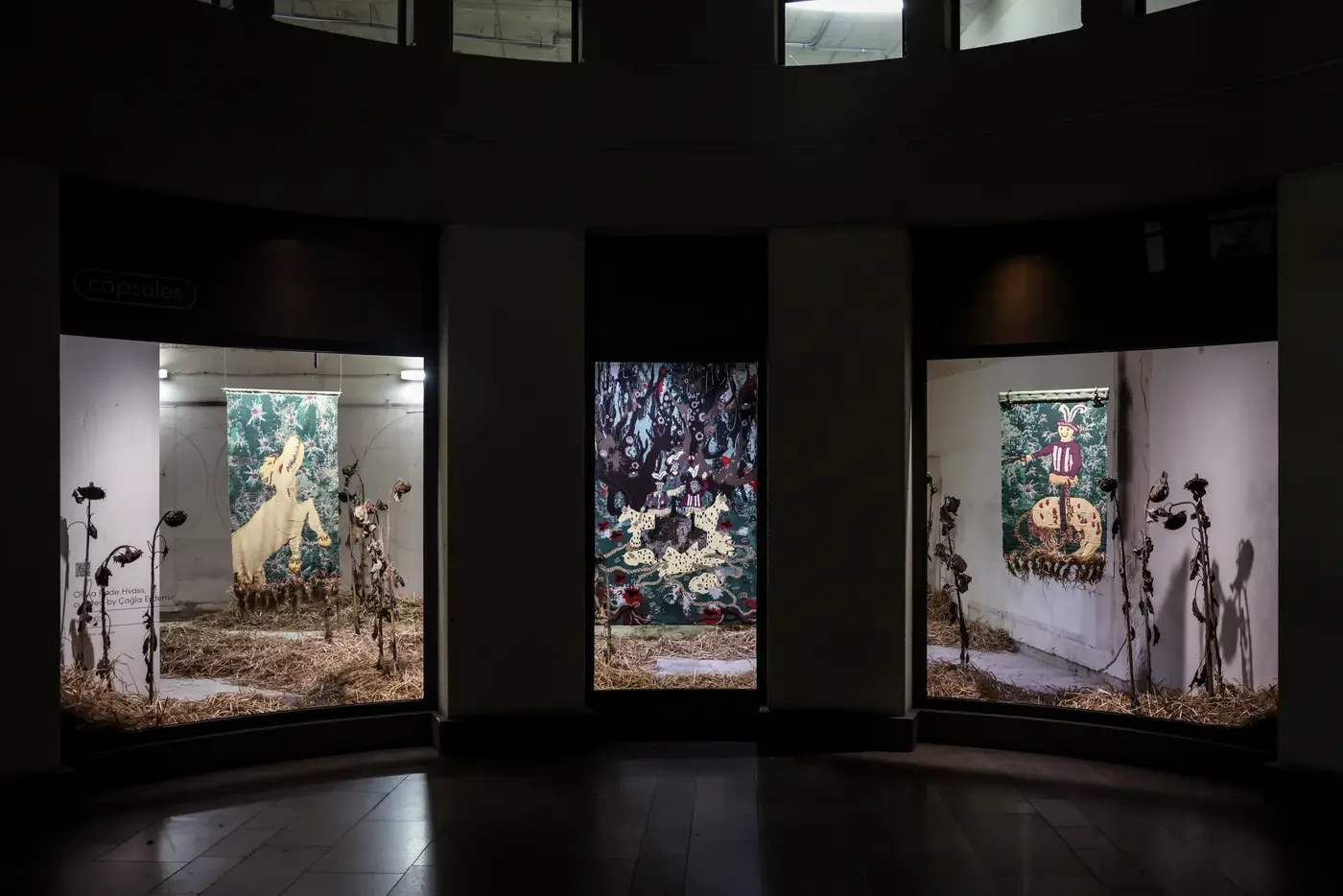
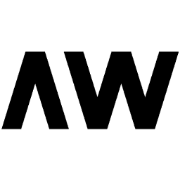

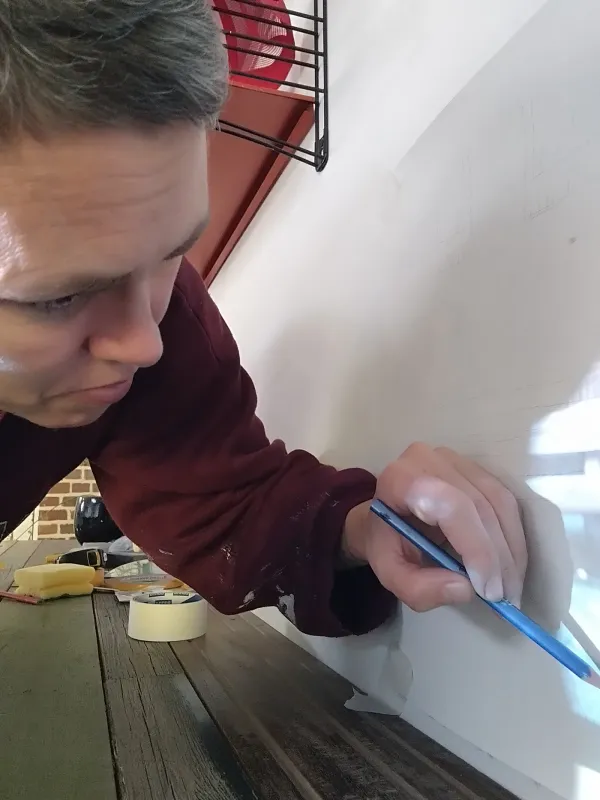



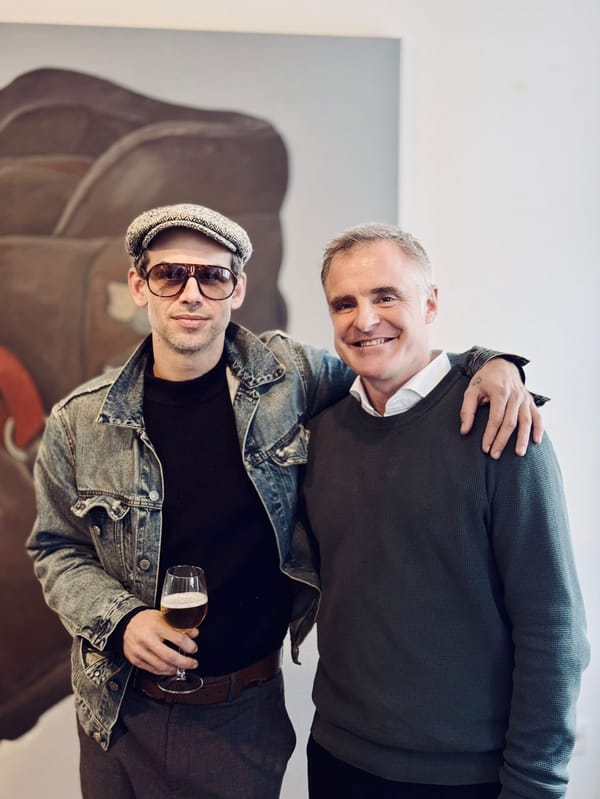

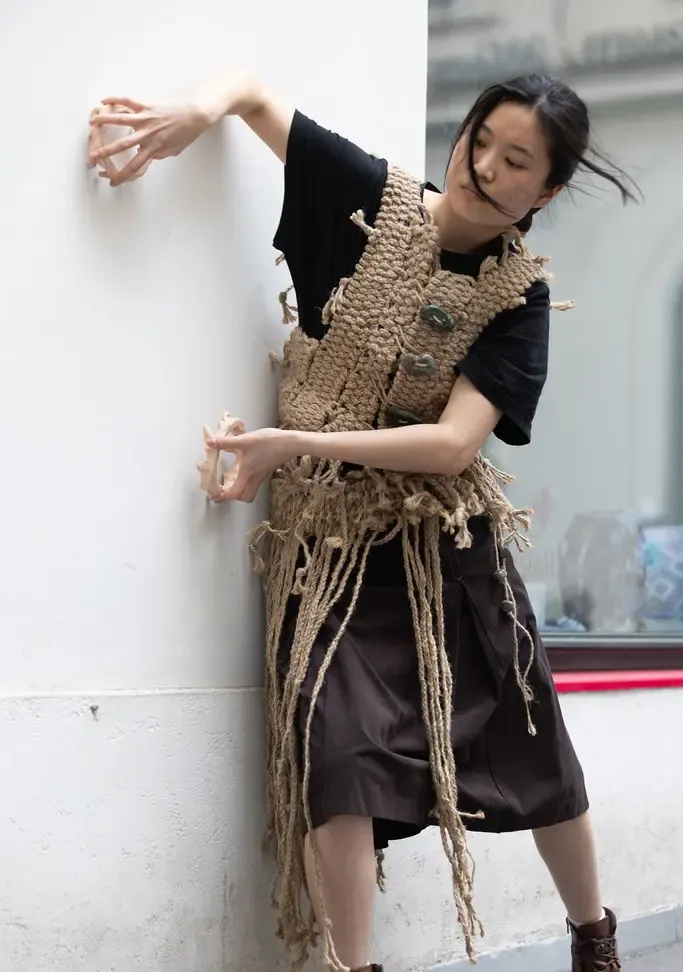
Member discussion